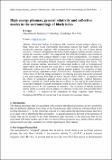| dc.contributor.author | Coppi, Bruno | |
| dc.date.accessioned | 2010-03-11T16:53:38Z | |
| dc.date.available | 2010-03-11T16:53:38Z | |
| dc.date.issued | 2009-12 | |
| dc.date.submitted | 2009-07 | |
| dc.identifier.issn | 0741-3335 | |
| dc.identifier.uri | http://hdl.handle.net/1721.1/52508 | |
| dc.description.abstract | The theoretical finding of composite disk structures around compact objects (e.g. black holes) and recent experimental observations indicate that highly coherent and dynamically important magnetic field configurations exist in the core of these plasma structures. Coherent configurations involving closed magnetic surfaces provide a means to resolve the 'accretion paradox' for a magnetized disk while the formation of jets emitted in the close vicinity of the compact object is related to these configurations. The absence of vigorous accretion activity in the presence of black holes in old galaxies can be attributed to the loss of the surrounding coherent magnetic configurations during their history. The relevant dynamics include axisymmetric (ballooning) modes as well as tridimensional spirals which can be excited from disks with a 'seed' magnetic field, under the effects of differential rotation and of the vertical plasma pressure gradient. The properties of these spirals are strongly dependent on their vertical structure. Axisymmetric modes can produce vertical flows of thermal energy and particles in opposing directions that can be connected to the winds emanating from disks in active galactic nuclei (AGNs). A similarity to the effects of temperature gradient driven modes in magnetically confined laboratory plasmas is pointed out. Spiral modes that are oscillatory in time and in the radial direction can produce transport of angular momentum toward the outer region of the disk structure, a necessary process for the occurrence of accretion. The excitation of radially localized density spirals co-rotating with the plasma, at a distance related to the Schwartzchild radius RS = 2GM*/c2, is proposed as the explanation for high frequency quasiperiodic oscillations (HFQPOs) of non-thermal x-ray emission from compact objects. | en |
| dc.description.sponsorship | U.S. Department of Energy | en |
| dc.language.iso | en_US | |
| dc.publisher | Institute of Physics | en |
| dc.relation.isversionof | http://dx.doi.org/10.1088/0741-3335/51/12/124007 | en |
| dc.rights | Attribution-Noncommercial-Share Alike 3.0 Unported | en |
| dc.rights.uri | http://creativecommons.org/licenses/by-nc-sa/3.0/ | en |
| dc.source | Meg Rheault for Bruno Coppi | en |
| dc.subject | astrophysics and astroparticles | en |
| dc.subject | gravitation and cosmology | en |
| dc.subject | plasma physics | en |
| dc.title | High energy plasmas, general relativity and collective modes in the surroundings of black holes | en |
| dc.type | Article | en |
| dc.identifier.citation | M. Lattanzi and G. Montani. “A separable solution for the oscillatory structure of plasma in accretion disks.” EPL (Europhysics Letters) 89.3 (2010): 39001. | en |
| dc.contributor.department | Massachusetts Institute of Technology. Department of Physics | en_US |
| dc.contributor.approver | Coppi, Bruno | |
| dc.contributor.mitauthor | Coppi, Bruno | |
| dc.relation.journal | Plasma Physics and Controlled Fusion | en |
| dc.eprint.version | Author's final manuscript | |
| dc.type.uri | http://purl.org/eprint/type/SubmittedJournalArticle | en |
| eprint.status | http://purl.org/eprint/status/PeerReviewed | en |
| dspace.orderedauthors | Coppi, B | en |
| dc.identifier.orcid | https://orcid.org/0000-0002-4920-8617 | |
| mit.license | OPEN_ACCESS_POLICY | en |
| mit.metadata.status | Complete | |
